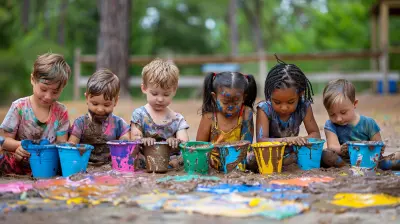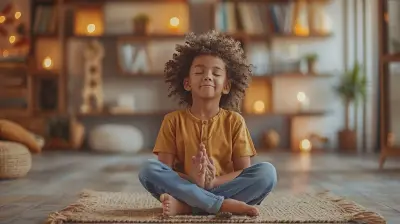19 April 2025
Creativity and mindfulness—two words that seem to belong in separate conversations. One is often associated with wild, free-flowing thoughts, while the other is about grounding yourself in the present. But what if I told you that these two seemingly different concepts are actually the perfect match?
Picture this: you're sitting with a paintbrush in hand, ready to create a masterpiece. But instead of frustration over getting every detail perfect, you’re fully engaged in the moment, feeling the texture of the canvas, noticing the way the colors blend, and appreciating the rhythm of each stroke. That’s mindfulness in art. Sounds peaceful, right?
In today’s fast-paced world, stress and anxiety creep into every aspect of our lives—including creative work. Integrating mindfulness into artistic subjects can transform not just the learning experience, but also the quality of the work itself. Let’s dive into how mindfulness can bring serenity and depth to the arts while nurturing creativity.

What is Mindfulness?
Before we get into the arts, let’s break down mindfulness in simple terms. Mindfulness is the practice of being fully present in the moment without judgment. It’s about focusing on what you’re doing right now rather than getting lost in past regrets or future anxieties.Mindfulness isn’t about stopping thoughts—it’s about noticing them and letting them pass, like clouds moving across the sky. When applied to artistic subjects, mindfulness allows artists, musicians, writers, and performers to tap into their creativity without being bogged down by self-doubt or external pressures.

How the Arts and Mindfulness Go Hand in Hand
1. Art as a Form of Meditation
Have you ever lost track of time while sketching, painting, or doodling? That’s mindfulness at work. When you're deeply engaged in an artistic activity, your mind slows down, and you enter a state of flow—where thoughts quiet down, and everything else fades away.Artistic expression is a natural form of meditation. Whether you're mixing colors on a canvas or molding clay with your hands, the repetitive, focused movements encourage relaxation. This meditative aspect of art can help reduce stress, lower anxiety, and improve overall emotional well-being.
2. Music and Mindful Listening
Music has a magical way of capturing emotions. But have you ever tried listening to music mindfully? Instead of letting it play in the background, really focus on it. Notice the individual instruments, the rhythm, the slight pauses, and the emotions behind the lyrics.For students and artists involved in music, mindfulness can enhance the way they interpret and perform. When a musician plays mindfully, they aren’t just hitting notes—they’re fully present in the music, feeling each vibration and allowing emotions to guide their performance.
3. Creative Writing and the Power of Presence
Writing is often accompanied by a constant internal battle—second-guessing every word, deleting sentences, and overthinking structure. Mindfulness can break this cycle.By practicing mindful writing, authors learn to write without judgment. This means embracing the raw, messy process of creativity, allowing thoughts to flow onto the page without constantly worrying about perfection. Journaling, for example, can be a fantastic way to combine mindfulness and creativity: just write whatever comes to mind without fear of “getting it right.”
4. Theater and Mindful Performance
Actors and performers deal with immense pressure. The fear of forgetting lines, performing in front of an audience, or not meeting expectations can create anxiety. Mindfulness helps performers stay present in each moment, allowing them to connect deeply with their characters and audience.By practicing mindful breathing and body awareness, actors can manage stage fright, stay focused, and deliver more authentic performances. When they're truly in the moment, their emotions and expressions feel more real, making their performances more compelling.

The Benefits of Integrating Mindfulness into Creative Subjects
Now that we've seen how mindfulness and the arts complement each other, let’s explore the benefits students and creatives can gain from this powerful combination.1. Reduces Stress and Anxiety
Creative subjects should be fun and fulfilling, yet many students feel pressure to produce perfect work. Mindfulness helps take the pressure off, allowing students to enjoy the process rather than stress over the outcome.2. Enhances Focus and Concentration
Ever notice how our minds love to wander? One minute you're painting, the next you're thinking about what to eat for lunch. Mindfulness strengthens our ability to focus, making it easier to stay immersed in creative projects.3. Encourages Self-Expression without Judgment
Many artists struggle with self-doubt and the fear of criticism. Mindfulness teaches students to create without judgment, embracing mistakes as part of the process rather than failures.4. Boosts Emotional Well-Being
Art is an outlet for emotions. When combined with mindfulness, creative expression becomes even more therapeutic. Whether through painting, music, or writing, mindfulness helps artists process feelings and find peace in their work.5. Improves Artistic Quality
When you're present and fully engaged in your craft, your work naturally improves. Whether it’s a more authentic performance, a deeper emotional connection to music, or a more vivid painting, mindfulness enhances creativity and artistry.
Practical Ways to Incorporate Mindfulness into Creative Learning
So, how can we start integrating mindfulness into artistic subjects? Here are some practical tips:1. Start with Mindful Breathing
Before beginning a creative activity, take a few deep breaths. Focus on your inhale and exhale, allowing yourself to settle into the present moment. This simple practice helps clear the mind and set the stage for creativity.2. Use Sensory Awareness
Engage your senses in the creative process. Feel the texture of a paintbrush, listen to the sound of a pencil against paper, or notice the weight of an instrument in your hands. The more you tune in to sensory details, the more immersed you’ll be in the experience.3. Avoid Multitasking
Mindfulness means focusing on one thing at a time. Resist the urge to check your phone or think about other tasks while creating. Give yourself the freedom to be fully present in your work.4. Practice Non-Judgmental Awareness
Let go of the need for perfection. Whether you're painting, singing, or writing, allow yourself to create without self-criticism. Mistakes are part of the process, and every stroke, note, or word adds to your growth.5. Take Breaks and Reflect
After finishing a creative session, take a moment to reflect. How did you feel during the process? Did you notice your mind wandering? Reflection helps reinforce mindfulness and brings awareness to your creative habits.Conclusion
Mindfulness and the arts are a match made in creative heaven. By integrating mindfulness into artistic subjects, students and artists can unlock deeper levels of creativity, reduce stress, and create with greater intention. In a world that constantly demands productivity and perfection, embracing mindfulness allows us to find peace in the process, rather than just the outcome.So next time you pick up a paintbrush, sit down to write, or play an instrument, take a deep breath. Be present. Feel the moment. Create with mindfulness, and watch your art transform.




Thane Warner
Essential link between creativity and mindfulness for wellness.
April 22, 2025 at 12:14 PM